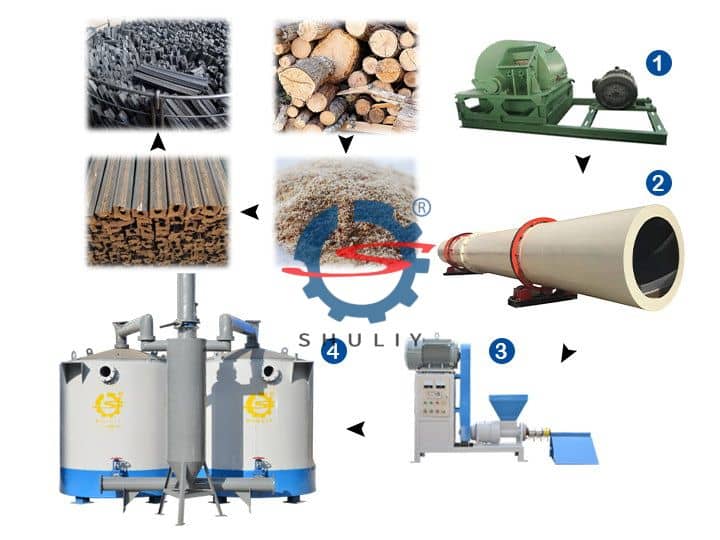Charcoal has been one of the most important energy sources for centuries. From ancient methods of burning wood in earth pits to today’s advanced industrial systems, charcoal remains a vital material in industries, households, and recreational activities. In recent years, the demand for high-quality charcoal has grown significantly, especially with the increasing popularity of hookah or shisha smoking worldwide. This trend has brought into focus two distinct but closely related fields: charcoal production in general and the specialized shisha charcoal production line.
This article provides a comprehensive 2500-word exploration of both topics. We will look at the history and science behind charcoal, modern production techniques, the role of advanced machinery, and how specialized lines for shisha charcoal meet unique market demands. Whether you are an entrepreneur, an investor, or simply curious about this fascinating sector, this guide will give you valuable insights.
1. Understanding Charcoal Production
1.1 What is Charcoal?
Charcoal is a lightweight, black residue consisting mostly of carbon. It is created by heating organic materials—primarily wood, coconut shells, or agricultural waste—in a low-oxygen environment. This process, called pyrolysis, drives out moisture and volatile compounds, leaving behind a concentrated carbon fuel.
1.2 Historical Roots
Charcoal production dates back thousands of years. Ancient civilizations used charcoal for smelting metals, cooking, and as medicine. Traditional methods often involved covering wood with soil and letting it smolder for days. While simple, these methods were inefficient and produced inconsistent results.
1.3 Modern Industrial Production
Today, charcoal production is an industrial process driven by technology, efficiency, and environmental responsibility. Modern systems employ carbonization furnaces, rotary kilns, dryers, crushers, and automated conveyors. These machines help achieve high output, uniform quality, and reduced emissions compared to old pit or kiln methods.
2. Key Processes in Charcoal Production
- Raw Material Preparation
- Wood logs, bamboo, coconut shells, and agricultural byproducts are commonly used.
- Crushing machines and grinders reduce materials to smaller, uniform sizes.
- Wood logs, bamboo, coconut shells, and agricultural byproducts are commonly used.
- Drying
- Moisture content directly affects charcoal quality.
- Industrial dryers reduce moisture to below 15%, ensuring efficient carbonization.
- Moisture content directly affects charcoal quality.
- Carbonization
- This is the heart of charcoal production.
- Furnaces operate at 400–700°C in oxygen-controlled environments.
- Volatile compounds evaporate, leaving carbon-rich charcoal.
- This is the heart of charcoal production.
- Cooling and Collection
- After carbonization, charcoal is cooled in sealed chambers to prevent spontaneous combustion.
- After carbonization, charcoal is cooled in sealed chambers to prevent spontaneous combustion.
- Crushing and Screening
- Charcoal is crushed and screened to desired particle sizes depending on use (powder, briquettes, lumps).
- Charcoal is crushed and screened to desired particle sizes depending on use (powder, briquettes, lumps).
- Briquetting or Shaping
- Many producers turn charcoal into briquettes for easier transport and consistent burning.
- Binders like starch may be used for strength.
- Many producers turn charcoal into briquettes for easier transport and consistent burning.
- Packaging
- Bags, cartons, or bulk containers are used depending on the target market.
3. Types of Charcoal Products
- Lump Charcoal – Natural, irregular pieces. Preferred for grilling.
- Charcoal Briquettes – Uniform, compressed pieces with steady burn rates.
- Activated Charcoal – Processed to increase surface area, used in medicine, filtration, and cosmetics.
- Shisha Charcoal – Specially designed for hookah smoking, requiring clean burn, uniform shape, and long heat retention.
4. The Rise of Shisha Charcoal
4.1 Global Hookah Trend
Hookah or shisha smoking has become a global cultural phenomenon. Once confined to the Middle East and parts of Asia, shisha lounges and bars are now common in Europe, North America, and beyond. This growing demand has fueled the need for high-quality shisha charcoal production line systems.
4.2 Why Shisha Charcoal is Different
Shisha charcoal differs from general charcoal in several ways:
- Must be odorless and tasteless to avoid affecting the flavor of shisha tobacco.
- Needs to be smokeless and produce minimal ash.
- Burns longer and more evenly.
- Compressed into specific shapes (cubes, discs, hexagons) for ease of use.
5. Inside the Shisha Charcoal Production Line
A shisha charcoal production line is a specialized system designed to produce high-quality charcoal tailored for hookah use. Let’s break down its stages:
5.1 Raw Material Selection
- Coconut shells, bamboo, and hardwoods are preferred.
- These materials provide clean combustion and minimal odor.
5.2 Carbonization
- Similar to general charcoal production but with stricter control.
- Ensures high fixed carbon content and low volatile matter.
5.3 Crushing and Grinding
- The charcoal is crushed into fine powder for shaping.
- Particle uniformity ensures consistent briquette strength.
5.4 Mixing and Binding
- Powder is mixed with natural binders like cassava starch.
- Water may be added to achieve workable consistency.
5.5 Shaping or Briquetting
- Hydraulic or mechanical presses mold the charcoal into cubes, discs, or hexagons.
- Consistency of shape and density is crucial for hookah smoking.
5.6 Drying
- Shaped briquettes are dried to remove excess moisture.
- Industrial dryers ensure strength and prevent cracking.
5.7 Packaging
- Products are often packed in branded boxes or cartons for retail sale.
- Attractive packaging is important for shisha market appeal.
6. Comparison: General Charcoal Production vs. Shisha Charcoal Production Line
| Aspect | Charcoal Production | Shisha Charcoal Production Line |
| Raw Materials | Wide variety: wood, bamboo, agri-waste | Mostly coconut shell, bamboo, or clean hardwood |
| Output | Lump, briquettes, activated charcoal | Shaped briquettes (cubes, discs) |
| Quality Standard | Focus on heat value and volume | Focus on clean burn, no odor, long duration |
| Machinery | Crushers, dryers, furnaces, briquetting machines | Similar, but with precision presses and packaging lines |
| Market | BBQ, industrial fuel, metallurgy | Hookah lounges, retail shisha users |
7. Economic Opportunities
7.1 Market Demand
- Global charcoal market expected to surpass USD 6 billion in coming years.
- Shisha charcoal segment growing rapidly due to lifestyle trends.
7.2 Profitability
- Shisha charcoal often sells at higher prices due to quality requirements.
- Export potential to Middle East, Europe, and North America.
7.3 Small vs. Large Scale
- Small businesses can start with modest production units.
- Large factories can scale with full shisha charcoal production line systems for mass export.
8. Environmental Considerations
Charcoal production has historically been linked to deforestation and pollution. Modern systems aim to address these issues:
- Sustainable raw materials – Using coconut shells, bamboo, and agricultural waste reduces environmental impact.
- Advanced furnaces – Capture emissions and improve efficiency.
- Recycling energy – Heat generated during carbonization can be reused in dryers.
Shisha charcoal production, in particular, has embraced eco-friendly raw materials, especially coconut shells, which are an agricultural byproduct.
9. Challenges in Charcoal and Shisha Charcoal Production
- Raw material supply – Consistent access to coconut shells or wood is critical.
- Energy consumption – High power demand for dryers and presses.
- Quality control – Especially strict for shisha charcoal, where small defects affect marketability.
- Competition – Growing global supply makes branding and quality differentiation essential.
10. Future Trends
- Automation and AI – Smart monitoring for temperature and moisture.
- Eco-branding – Marketing charcoal as sustainable can attract premium buyers.
- Product diversification – Beyond shisha, companies are developing quick-light charcoals and flavored briquettes.
- Regional expansion – Africa, Southeast Asia, and the Middle East will continue to drive production and consumption.
Conclusion
Charcoal has come a long way from traditional pit burning to today’s high-tech factories. The global market continues to expand, offering vast opportunities for entrepreneurs and manufacturers. For general fuel needs, charcoal production remains a cornerstone of industry and daily life. But the booming popularity of hookah has carved out a lucrative niche, making the shisha charcoal production line a highly profitable and specialized business.
With the right equipment, sustainable raw materials, and attention to quality, producers can meet growing global demand while contributing to eco-friendly practices. Whether you are looking to supply industrial buyers or serve the lifestyle-driven shisha market, the future of charcoal is bright—and the technology behind it is more advanced than ever.


